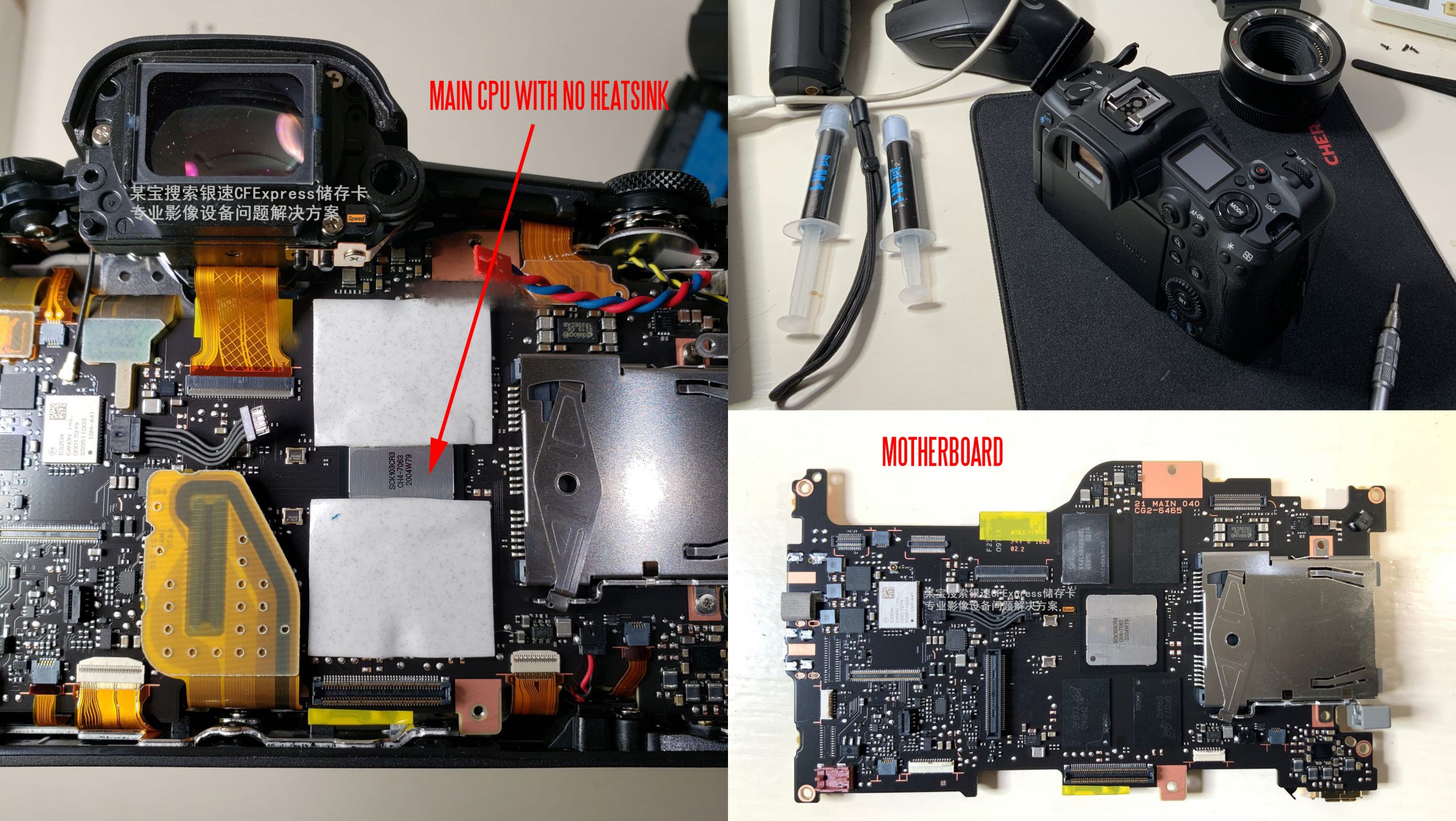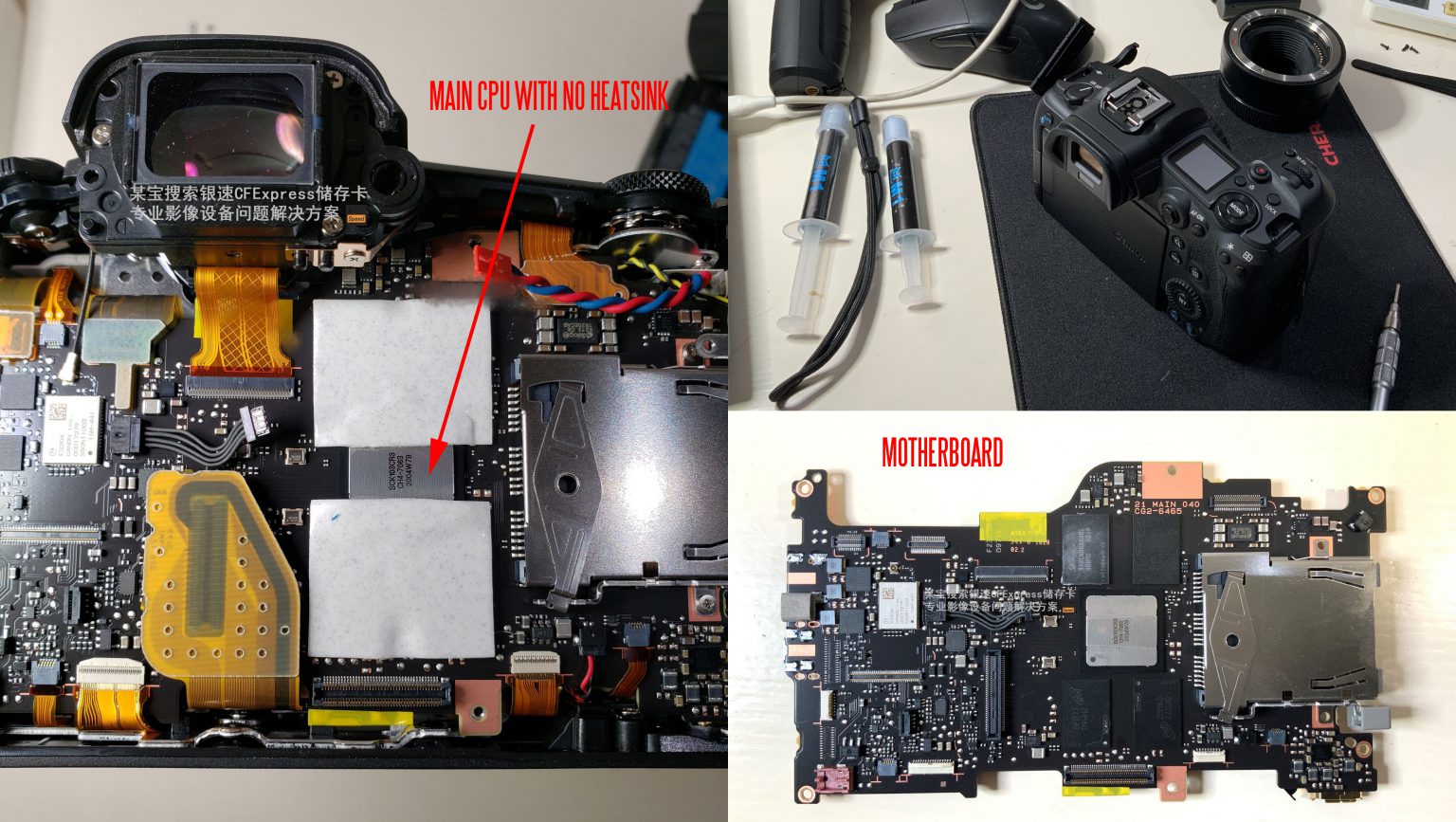

A Chinese user/engineer disassembled the Canon EOS R5 with the aim of studying overheating.
The hardware is laid out in such a way to trap heat around the CPU.
In a Baidu post detailing the teardown here in Chinese, we see a detailed inspection of the EOS R5 hardware. Thanks to “AndroidLad” on the EOSHD Forum for the find.
The EVF panel is Sony’s “ecx339a”, it has a thermally conductive material on the back.
Surrounding the main image processor are four high speed memory chips (LPDDR4 3733), these also have thermal pads to conduct heat away.
Immediately you notice something strange. There is no thermal pad on the main CPU, and even an entire second circuit board sits on top of the CPU preventing it from effectively conducting heat directly onto the magnesium alloy chassis that Canon claims mitigates overheating.
What is even more odd, is that the RAM thermal pads overlap 2 thirds of the CPU. This is a worst case scenario, spreading heat from the RAM chips towards the CPU. They don’t cover it all – the critical central core of the CPU is bare – but they do cover it a bit and I cannot appreciate the rationale behind either approach. It’s obvious that the RAM and CPU should have separate thermal conductive surfaces – three separate pads – one for the top two DDR4 chips, one for the CPU and one for the bottom two DDR4 chips.
An infrared thermometer was used to gauge CMOS sensor temperature, revealing it not to be the “heat limited” part of the EOS R5 – it didn’t even measure above 40 degrees.
The Chinese user’s EOS R5 was then rebuilt with thermal paste over the CPU, allowing more heat to travel outwards away from the CPU and towards the back of the magnesium alloy casing. After measuring this area with the thermometer again, the readout shows the CPU (main image processor) to be the main source of heat in the camera.
However, even with the improved conductivity between CPU and the back casing (albeit with PCB still in the way), the camera again shut down at 20 minutes, as if this is a fixed timer in firmware.
Measured temperature doesn’t seem to exceed 47 degrees looking at the photos of his thermometer. It’s important to realise that a modern CPU is designed to run hot, up to 95 degrees in your laptop as just one example, before thermal throttling kicks in. A CPU without thermal paste at all? You would not even build a $200 PC like this. The 47 degrees back of the camera implies the CPU in the EOS R5 is nowhere near at critical temperature during 8K recording – and if it does in fact get too hot, it appears heat is allowed to build up in the camera due to design choices that are absolutely baffling and that no engineer would sign off in their right mind relating to the internal layout.
Dramatically altering ambient temperature didn’t seem to make a difference either to recording times. A number of people have confirmed this. I’ve even had ice on the back of my EOS R5 and the record limit in 8K kept decreasing, from 10 mins to 5, with the camera just sat idle in the menus.
EOSHD opinion
Everything I’ve seen points to overheating being avoidable.
The questions for Canon are numerous and we as customers should be seeking the answers. For example, what is the thermal limit (in degrees C) of the processor? Why does the Canon API documentation claim you are able to poll the temperature, but the camera only returns a text status like “Normal” rather than a real temperature in Celsius? Why is this all-important temperature readout obscured?
And I have more questions:
- If the processor truly does get overly hot, why at the very least doesn’t it have its own thermal pad to ensure the reliability of the part?
- Why do the RAM thermal pads cover 2 thirds of the processor with sloppy placement?
- Why did Canon see fit to put thermally conductive material on the back of the EVF but not the more heat critical CPU?
- What’s going on with the firmware? Is it actually measuring the degrees Celsius of the CPU or imposing an arbitrary countdown limit?
- Why are the recovery times so long even when ice is applied to the back of the camera just millimetres from the CPU?
- Supposing the CPU does in fact get so hot that the camera has to shut down to protect itself, is this heat potentially damaging long term?
- Why doesn’t ambient temperature seem to meaningfully impact the maximum recording times in 8K?
The issue I see here is:
If this is an artificial limit in firmware, Canon has the chance to reverse this decision but it involves admitting to their customers that they lied.
It also involves a huge loss of face in Japan and possible resignations.
If the limit is indeed hardware related, this probably requires an expensive redesign and recall.
However if Canon doesn’t do anything at all, and allows this faulty camera to continue shipping, the harm to their brand (and long term sales) is incalculable.
I cannot in any sense imagine any Canon engineer thought that arrangement of circuit board blocking the CPU, and no thermal pad would satisfy the criteria of good electronic design. So the only conclusion I can come to is that it’s intentional. All the signs, in my opinion, point to Canon crippling the EOS R5 to segment it from Cinema EOS.
If they actually genuinely wanted to mitigate heat build-up inside the EOS R5, then at the very least you’d expect the CPU to have some thermally conductive material on it like the RAM does, and conduct directly onto the back of the alloy casing without the extra circuit board in the way.
The other very odd thing is how Tilta managed to release an “EOS R5 fan” so quickly – mere days after the camera was announced and the first news of overheating came in. In my opinion, I just cannot imagine how this product came to market so quickly without advance knowledge of what was planned by Canon before the official overheating timings were announced.
It’s also extremely unusual not to see a small copper heat-pipe and thin 2mm heatsink in the camera, to conduct thermal energy away from the core of the electronics to the bottom of the chassis or outside of the casing. An easy, common solution.
As shown on the 1D X Mark II spare parts list, this camera features a heat pipe on the LSI board. Indeed, the comparatively small size of a mirrorless camera body does not make a thin copper heat spreader and heat pipe impossible to implement because such things are present even on smartphones and add only incredibly minimal weight and thickness gains.
All in all, these findings make me deeply suspicious and distrustful of what Canon is telling us and why the hardware is laid out as it is.
If it is proven that Canon purposefully hobbled the camera, or artificially restricted recording times in firmware, with heat as an excuse, in all the highest quality video modes on the EOS R5 they advertised as key headline grabbing features, I will never buy another Canon camera again for as long as I live and I think the full force of consumer law should be brought to bear.




